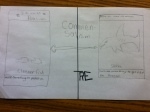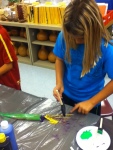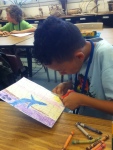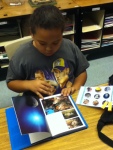In today’s lesson the class differentiated between the three types of symbiosis: mutualism, commensalism, and parasitism. We explored examples of these types of relationships through a game where each student was given an organism card with hints. The students went around the room and had to find their “symbiotic partner” and identify which of the three types of relationships their organisms shared. Finally, using their creativity skills, they depicted the different symbiotic relationships on paper.
Symbiosis
Standard: (HCPS III) SC.4.3.2 – Student describes how an organism’s behavior is affected by its environment. SC.MS.5.3 – Student classifies symbiotic relationships in the marine environment.
TSWBAT: Identify the different types of symbiosis by playing a card game that will help them match marine animals with their symbiotic partners.
Materials:
- exploration of the three types of symbiosis
- symbiosis card game
- videos of symbiotic relationships
Vertebrates
Today the small group of Jefferson Marine Club students expanded on last weeks lesson and talked about vertebrates. We used dichotomous keys for cetacean species and shark species, students got to test what they learned last week about the keys to label different species in these categories. We also had sample specimens that the students classified as vertebrate or invertebrate and then used for a Gyotaku activity. Some students were excited to feel the creatures while others took a little longer to warm up to the idea of touching them!
Vertebrates
Standard: (HCPS III) SC.MS.5.2 – The student classifies planktonic, invertebrate, and vertebrate organisms based on their characteristics. SC.Z.3.3 – The student classifies organisms as vertebrates or invertebrates.
TSWBAT: Demonstrate their understanding of marine vertebrates using dichotomous keys to figure out some marine vertebrate species.
Materials:
- dichotomous keys for some vertebrate species
- samples of dead or live marine vertebrates
- paint/brushes/paper
Invertebrates
This Friday, Jefferson students learned what a dichotomous key was by comparing it to the handheld 20Q game. Each student then practiced using a simple invertebrate dichotomous key to classify some organisms into the correct phylum: porifera, cnidaria, echinodermata, arthropoda, and mollusca. We then used our classifications to identify some of the defining characteristics of each phylum. These included nematocysts, radial symmetry, segmented bodies, soft bodies and hard shells. In addition to these differences, we concluded that one thing all these organisms had in common was the lack of a backbone
Invertebrates
Standard: (HCPS III) SC.MS.5.2 – The student classifies planktonic, invertebrate, and vertebrate organisms based on their characteristics. SC.Z.3.3 – The student classifies organisms as vertebrates or invertebrates.
TSWBAT: Define a marine invertebrate and use a dichotomous key to categorize some marine invertebrates based on physical characteristics.
Materials:
- invertebrate dichotomous key
- examples of marine invertebrates
- invertebrate activity
Endangered Species
Jefferson Marine Club had so much fun learning acronyms last week that we added a few more this week. Building on our last lesson to cover endangered species in Hawaii, we briefly talked about the Marine Mammal Protection Act (MMPA) and Endangered Species Act (ESA) and then focused in on Hawaiian Islands Humpback Whale National Marine Sanctuary (HIHWNMS), whew! Considering we are right in the middle of “whale season” here in Hawaii, we talked about the Sanctuary Ocean Count that monitors Humpback population and distribution around Oahu, Hawaii, and Kauai. We discussed a few of the behaviors that the Ocean Count observes: Blow, Breach, Pectoral Slap, Tail Slap, and Dive. The students then spent the rest of our time designing their own protected species puzzles!
Marine Protected Area
Reef Watch Waikiki intern, Stacey, led the Marine Club students in a game-like discussion about Marine Protected Areas today. She introduced Marine Life Conservation Districts (MLCD), Fisheries Management Areas (FMA), and Marine Protected Areas (MPA) and helped the students identify the differences in these areas. We discussed examples on Oahu such as Waikiki beach, Hanauma Bay, and Waimea Pupukea and talked about what kinds of marine animals/organisms would be protected in these areas. The students created informational posters about these areas and then did a “reef” scavenger hunt by finding certain species in picture books that were provided.
Marine Protected Area
Standard: (HCPS III) SC.MS.6.6 – Student describes how to effectively manage ocean resources.
TSWBAT: Define a marine protected area and describe why they are important, identify protected species in Hawaii.
Materials:
- MPA maps
- blank protected species puzzles
Guest MOP Student!
Ryan Tabata, a Marine Option Program Student at the University of Hawaii at Manoa, came to share some cool experiences with the Marine Club students! Ryan talked about his trip to the Northwestern Hawaiian Islands and some of the scientific opportunities he was involved in. Students then got to explore the meaning of “abundance” and “diversity” by examining samples of M&M’s, similar to the kind of sampling that Ryan explained took place on the boat. Finally, since the NWHI contain an ‘abundance’ of coral we asked Ryan to dive into some detail about how corals live and feed, and challenged them by talking about the zooxanthellae symbiosis. Students got to make their own coral polyps out of egg cartons which they could use to demonstrate how the polyps look during daylight and nighttime hours.

















